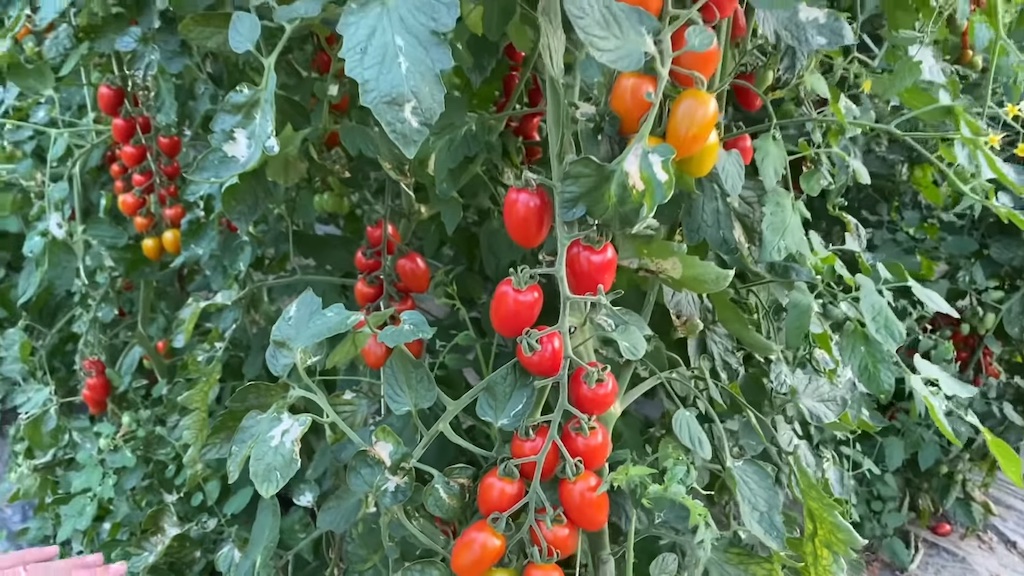Welcome to the very first installment of our new series: Know Your Italian Tomatoes! This post will cover everything you need to know about Datterinis – including how to get your hands on them.
Datterini Description
In Italian “datterino” means “little date”, a name given to this tomato-based on its similarity to its namesake’s size, shape, and sweetness. Datterinis are a particularly sweet and rich variety that have thick soft skin, few seeds, and lots of flesh. They are quite delicate, so cooking with them is generally very fast, although they’re just as good raw as cooked.
Often they’ll be described as a type of cherry tomato, but they’re in fact a variety of mini plum tomato. They come in two varieties: red and yellow, and the yellow ones are even sweeter than the red – probably the sweetest of all tomato varieties!
Datterini Nutrition
There isn’t a ton of variation in the nutritional profile of different types of tomatoes. One key (and unsurprising) difference is that datterini tomatoes have a slightly higher sugar content than their less-sweet brethren.
All tomatoes are pretty famous for being high in lycopene – an antioxidant known to have positive effects on aging and to inhibit certain types of cancer. Unless you’re on an acid-restricted diet tomatoes are great for you, and datterini are definitely included in that list.
Datterini Recipes
The sweetness is the defining characteristic of this tomato, and the ideal recipes for this variety reflect that fact. Any recipes that include a sour or bitter ingredient would be balanced particularly well with datterinis.
Recipe roundup:
- Pasta with Lardo (Ziti Lardiati)
- Spaghetti with Zucchini Pesto
- Bruschetta Trio
- Pasta with calamari and datterini tomatoes
- Pasta with Yellow Datterino Tomatoes and Pancetta
- Bass fillet with datterini tomatoes and taggiasche olives
- Paccheri With Datterini Tomatoes & Stracciatella
- Sauteed Mushrooms and Datterini Tomatoes
Datterini Substitute
- Corbarino – a small variety from Campania that has similar flavor attributes, is suitable for authentic Neapolitan pizza, and is amazing in sauces and soups. These are slightly larger than Datterini, are a bit sweeter, and have similar acidity
- Piennolo del Vesuvio – are grown in the same region and are also small and sweet, but have a slightly bitter finish to the taste.
- Cherry or Grappolo Pachino – the smaller varieties of the Pachino tomatoes are delicious and not dissimilar in flavor profile to the Datterini.
- Cherry tomatoes are approximately the same size and sweetness as datterini and are more or less interchangeable
- Grape tomatoes are a lot less sweet than datterini, so you would likely substitute them in recipes where added sweetness would be desired. For example, if your recipe includes something sour like goat cheese or really salty like anchovies
- Plum tomatoes such as San Marzano or Roma can be substituted in recipes that involve canned peeled tomatoes. Datterinis are, after all, mini plums!
Where to Buy Datterini Tomatoes
All this advice applies to the US. For our friends in other countries, I’d love to hear how you order datterinis!
Fresh
If you want fresh, raw datterini tomatoes, you are going to have your work cut out for you! Your best chance is likely in major metro areas, especially if there is a sizeable Italian population (or at least a large number of Italian restaurants). If you find them fresh on a local restaurant’s menu, don’t hesitate to ask to talk to the chef and ask them what produce supplier they get theirs from. Also, go to your local Italian grocery store and ask there. There’s a chance they may have them if they have fresh produce, but my local shops don’t.
Alternately, if your city or town has a sizable farmers’ market where there is a lot of specialty and/or heirloom produce, you may be able to find someone growing them. They’ll only be available in the growing season, but that’s a good thing – they’ll be ripened on the vine and taste incredible.
Canned/Jarred
If you want canned tomatoes, it will be pretty easy to track them down. Obviously, the first place to stop is your local Italian grocery store. You can likely find them on the shelf if you have a fancy grocery store (Whole Foods, Sprouts, Fresh Market, etc).
If not, there are so many places you can order them online. One thing to note – they can be remarkably expensive. Some of the jars on Amazon are $14 EACH or are only sold in large packs. Eataly has both red and yellow for under $10 so you can try them out without paying a small fortune.
Eataly:
- Così Com’è – Whole Red Datterino Tomatoes
- Così Com’è – Whole Yellow Datterino Tomatoes
- Bio Orto – Organic Datterini Tomatoes
Amazon:
- Così Com’è – Whole Yellow Datterino Tomatoes Unpeeled
- Così Com’è – Datterino Giallo (Yellow)
- Così Com’è – Datterino Rosso (Red)
- Colavita – Datterini Canned Tomatoes
- Cento – Whole Datterini Tomatoes
- Mutti – Baby Roma Tomatoes (Datterini)
Elsewhere:
How to grow Datterini tomatoes
If you happen to have a green thumb, and really want fresh tomatoes, you can always grow them yourself. If you can grow *any* variety of tomatoes where you live, you’ll be able to grow these. They want full sun, warm and well-drained soil, and the temperature has to stay below 95ºF (and below 85ºF at night). You should be able to get from seed to fruit within 90 days in ideal conditions (healthy soil, appropriate water, full sunlight, and goldilocks temperatures)
Seeds are surprisingly difficult to find, even online. Here are a few places you can buy seeds online if your local nursery doesn’t carry them. Be warned, most of these seed suppliers are based in Europe:

